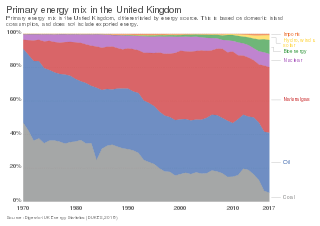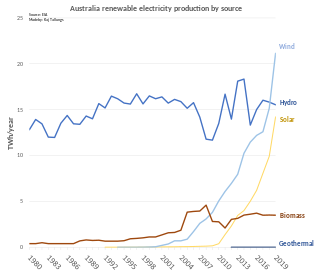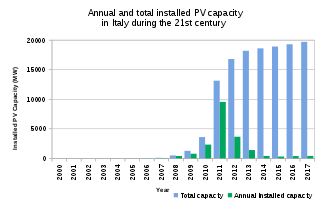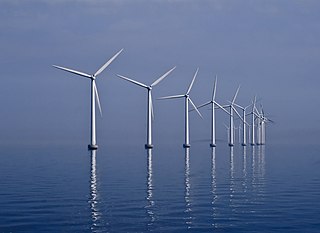Related Research Articles
The Renewables Obligation (RO) is designed to encourage generation of electricity from eligible renewable sources in the United Kingdom. It was introduced in England and Wales and in a different form in Scotland in April 2002 and in Northern Ireland in April 2005, replacing the Non-Fossil Fuel Obligation which operated from 1990.

The energy policy of the United Kingdom refers to the United Kingdom's efforts towards reducing energy intensity, reducing energy poverty, and maintaining energy supply reliability. The United Kingdom has had success in this, though energy intensity remains high. There is an ambitious goal to reduce carbon dioxide emissions in future years, but it is unclear whether the programmes in place are sufficient to achieve this objective. Regarding energy self-sufficiency, UK policy does not address this issue, other than to concede historic energy security is currently ceasing to exist.

The United Kingdom is the best location for wind power in Europe and one of the best in the world. By 2023, the UK had over 11 thousand wind turbines with a total installed capacity of 28 gigawatts (GW): 14 GW onshore and 14 GW offshore, the sixth largest capacity of any country. Wind power is the largest source of renewable energy in the UK, but at under 5% still far less primary energy than oil or fossil gas. Wind generates more than a quarter of UK electricity, but less than gas over a whole year.
Community Energy Scotland is an independent Scottish charity established in 2008 that provides advice and financial support for renewable energy projects developed by community groups in Scotland. The stated aim of Community Energy Scotland is 'to build confidence, resilience and wealth at community level in Scotland through sustainable energy development'.

The production of renewable energy in Scotland is a topic that came to the fore in technical, economic, and political terms during the opening years of the 21st century. The natural resource base for renewable energy is high by European, and even global standards, with the most important potential sources being wind, wave, and tide. Renewables generate almost all of Scotland's electricity, mostly from the country's wind power.
Energy Saving Trust is a British organization devoted to promoting energy efficiency, energy conservation, and the sustainable use of energy, thereby reducing carbon dioxide emissions and helping to prevent man-made climate change. It was founded in the United Kingdom as a government-sponsored initiative in 1992, following the global Earth Summit.

Renewable energy in Australia includes wind power, hydroelectricity, solar photovoltaics, heat pumps, geothermal, wave and solar thermal energy.

Wind power is the fastest-growing renewable energy technology in Scotland, with 11,482 megawatts (MW) of installed wind power capacity by Q1 2023. This included 9,316 MW from onshore wind in Scotland and 2,166 MW of offshore wind generators.

Renewable energy in the United Kingdom contributes to production for electricity, heat, and transport.
As of 2021 The island of Ireland has 5,585 megawatt and the Republic of Ireland has 4,309 MW of installed wind power nameplate capacity, the third highest per capita in the world. In 2020 wind turbines generated 36.3% of Ireland's electrical demand, one of the highest wind power penetrations in the world.

Sustainable development in Scotland has a number of distinct strands. The idea of sustainable development was used by the Brundtland Commission which defined it as development that "meets the needs of the present without compromising the ability of future generations to meet their own needs." At the 2005 World Summit it was noted that this requires the reconciliation of environmental, social and economic demands - the "three pillars" of sustainability. These general aims are being addressed in a diversity of ways by the public, private, voluntary and community sectors in Scotland.
Energy policy in Scotland is a matter that has been specifically reserved to the UK parliament under the terms of the Scotland Act 1998 that created the devolved Scottish Parliament. However, since planning is a matter that has been devolved, the Scottish government has the ability to shape the direction of energy generation in Scotland by approving or refusing new projects.
Energy subsidies are measures that keep prices for customers below market levels, or for suppliers above market levels, or reduce costs for customers and suppliers. Energy subsidies may be direct cash transfers to suppliers, customers, or related bodies, as well as indirect support mechanisms, such as tax exemptions and rebates, price controls, trade restrictions, and limits on market access.

Community wind projects are locally owned by farmers, investors, businesses, schools, utilities, or other public or private entities who utilize wind energy to support and reduce energy costs to the local community. The key feature is that local community members have a significant, direct financial stake in the project beyond land lease payments and tax revenue. Projects may be used for on-site power or to generate wholesale power for sale, usually on a commercial-scale greater than 100 kW.
Possible is a charity that enables people to take practical action on climate change, and combines these local actions to inspire a more ambitious approach to the issue at every level of society.

Climate change in Scotland is causing a range of impacts on Scotland, and its mitigation and adaptation is a matter for the devolved Scottish Parliament. Climate change has already changed timings of spring events such as leaf unfolding, bird migration and egg-laying. Severe effects are likely to occur on biodiversity.

Solar power is an important contributor to electricity generation in Italy, accounting for 8% of the total in 2017. As of 2022, the country has a total installed capacity of 22.56 GW. In 2019, Italy set a national goal of reaching 50 GW by 2030.
De Aar Solar Power is located 6 km outside the town of De Aar in the Northern Cape Province of South Africa. The facility is based on over 100 hectares of Emathanjeni Municipal land, and comprises 167,580 solar (PV) panels. De Aar Solar Power supplies Eskom with 85,458 MWh of renewable electrical energy per year; enough to power more than 19 000 average South African households.

Green industrial policy (GIP) is strategic government policy that attempts to accelerate the development and growth of green industries to transition towards a low-carbon economy. Green industrial policy is necessary because green industries such as renewable energy and low-carbon public transportation infrastructure face high costs and many risks in terms of the market economy. Therefore, they need support from the public sector in the form of industrial policy until they become commercially viable. Natural scientists warn that immediate action must occur to lower greenhouse gas emissions and mitigate the effects of climate change. Social scientists argue that the mitigation of climate change requires state intervention and governance reform. Thus, governments use GIP to address the economic, political, and environmental issues of climate change. GIP is conducive to sustainable economic, institutional, and technological transformation. It goes beyond the free market economic structure to address market failures and commitment problems that hinder sustainable investment. Effective GIP builds political support for carbon regulation, which is necessary to transition towards a low-carbon economy. Several governments use different types of GIP that lead to various outcomes. The Green Industry plays a pivotal role in creating a sustainable and environmentally responsible future; By prioritizing resource efficiency, renewable energy, and eco-friendly practices, this industry significantly benefits society and the planet at large.

A renewable energy cooperative is a decentralized, non-governmental initiative of local communities and citizens to promote the production and consumption of renewable energy. It is formed by a group of community members that share a common long-term goal for a sustainable future of energy and work to advance the transition through active citizenship involvement. In this way, the citizens are prosumers: they act as both producers and consumers in an attempt to democratize energy supplies by shifting away from relying on large companies.
References
- ↑ Government Community And Renewable Energy Scheme (CARES), Scotland.gov.uk
- ↑ "Scotland delivers £2.5m to help communities plug into renewable energy". Click Green. 5 March 2014. Retrieved 12 March 2014.